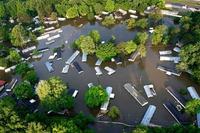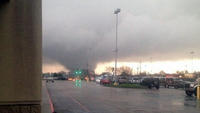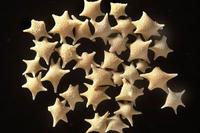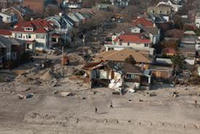-
Making communities more resilient to climate-induced weather disasters
Mounting scientific evidence indicates climate change will lead to more frequent and intense extreme weather that affects larger areas and lasts longer. We can reduce the risk of weather-related disasters, however, with a variety of measures. Experts say that a good strategy should include a variety of actions such as communicating risk and transferring it through vehicles such as insurance, taking a multi-hazard management approach, linking local and global management, and taking an iterative approach as opposed to starting with a master plan.
-
-
Toxic legacy of lead pollution persists despite regulatory efforts, modest gains
Efforts to reduce lead pollution have paid off in many ways, yet the problem persists and will probably continue to affect the health of people and animals well into the future. The good news, he said, is that atmospheric lead concentrations in the United States have fallen by 89 percent in the past three decades.The bad news is that blood lead levels are still about 100 times higher than the natural background level, and there is no known threshold for lead toxicity. In other words, even tiny amounts of lead in the body can be harmful.
-
-
Lessons from the 2010-11 Australia floods
New research has come up with ways quickly to assess flood damage to houses while also showing most people did not intend to make changes to reduce their vulnerability after the 2010-11 Australia floods. Two separate reports show how lessons learned from households affected by the 2010-11 Australian floods can minimize damage under current and future climates.
-
-
Sediment carried by 2011 Mississippi flood shored up Louisiana’s wetlands

The spring 2011 flood on the Mississippi was among the largest floods ever, the river swelling over its banks and wreaking destruction in the surrounding areas. A new study also shows, however, that the floods reaped environmental benefits — transporting and laying down new sediment in portions of the Delta — that may help maintain the area’s wetlands.
-
-
Expanding biological control of crop pests
A new discovery promises to allow expanded use of a mainstay biological pest control method, which avoids the health, environmental, and pest-resistance concerns of traditional insecticides, scientists are reporting. This advance broadens the applicability of the so-called sterile insect technique (SIT).
-
-
The Middle East rapidly losing fresh water

A new study using data from a pair of gravity-measuring NASA satellites finds that large parts of the arid Middle East region lost freshwater reserves rapidly during the past decade. Scientists found during a seven-year period beginning in 2003 that parts of Turkey, Syria, Iraq, and Iran along the Tigris and Euphrates river basins lost 117 million acre feet (144 cubic kilometers) of total stored freshwater. That is almost the amount of water in the Dead Sea. The researchers attribute about 60 percent of the loss to pumping of groundwater from underground reservoirs.
-
-
Cleanup starts after Mississippi tornado, storms

Emergency officials in Mississippi spent Monday dealing with the damage after a number of storms and a tornado ripped through the southern section of the state, injuring at least sixty people. No deaths were reported.
-
-
Northeast U.S. digs out after deadly snowstorm

About 250,000 homes and businesses in northeast United States remain remained without power this morning as a blizzard dumped more than three feet of snow on north-mid-Atlantic and New England states, and parts of Canada. The death toll was at fifteen. Utilities in New England said the storm could leave some customers in the dark at least until Tuesday. About 650,000 lost power in eight states at the height of the storm.
-
-
Idaho debating nuclear waste storage
For two decades, the Yucca mountain nuclear waste repository in Nevada was viewed as a long-term solution to the growing problem of radioactive waste generated by the 104 active nuclear power generation plants in the United States. One of the Obama administration’s first acts was to “defund” the project, in effect outing an end to it. States such as Texas, New Mexico, and North Carolina have fashioned their own interim solution to the problem of nuclear waste storage, and the governor of Idaho wants his state to follow these states’ example.
-
-
Tiny organisms in oceans can save islands from rising sea levels: study

Warming climate is causing sea levels to rise, posing a special threat to low-lying island nations. The government of the Maldive Islands, an island nation in the Indian Ocean consisting of a chain of twenty-six atolls, has begun exploring the possibility of purchasing land in Africa to relocate the entire population – about 330,000 – once rising sea water begin to swallow the small atolls. Scientists found out, though, that the warming temperature of the seas is causing tiny single-cell organisms to are spreading rapidly through the world’s oceans, where they just might be able to mitigate the consequences of climate change.
-
-
Hydroelectric power generation superior to nuclear and coal, beats oil and gas

Researchers have reviewed the economic, social, and environmental impact of hydro, coal, oil, gas, and nuclear power. Each has its advantages and disadvantages, but of these conventional electricity generation technologies, hydroelectric power appears to be the most sustainable and acceptable environmentally and economically.
-
-
Old, faulty bores jeopardize Australia's water
Australian homes, towns, cities, farmers, and miners will rely increasingly on underground water as the country’s population grows, surface water supplies dwindle, and as droughts multiply under a warming climate. Trouble is, the authorities in charge do not have a clear idea exactly how much groundwater there is, how rapidly it is recharged — or how quickly it is being depleted. What is known is based on data largely supplied by 23,000 monitoring bores spread across the continent — more than two thirds of which are now falling into disrepair.
-
-
NY to buy, demolish beachfront homes, make way for storm buffers

New York governor Andrew Cuomo plans to use $400 million in federal funding to buy beachfront homes as part of a broader plan to reshape the New York coastline so the state is better prepared for sea level rise, surges, and storms. The plan is to raze the purchased homes and leave to shore front vacant. Some properties would be turned into dunes, wetlands, or other natural buffers. Other parcels could be combined and turned into public parkland.
-
-
New clean coal technology provides energy without burning
A new form of clean coal technology reached an important milestone recently, with the successful operation of a research-scale combustion system. The technology is now ready for testing at a larger scale. For 203 continuous hours, the combustion unit produced heat from coal while capturing 99 percent of the carbon dioxide produced in the reaction.
-
-
The humble sea urchin may hold the key to carbon capture
Each year, humans emit on average 33.4 billion metric tons of CO2 — around 45 percent of which remains in the atmosphere. At present, pilot studies for Carbon Capture and Storage (CCS) systems propose the removal of CO2 by pumping it into holes deep underground. This is a costly and difficult process, and it carries with it a long term risk of the gas leaking back out — possibly many miles away from the original downward source. An alternative solution is to convert the CO2 into calcium or magnesium carbonate.
-
- All
- Regional
- Water
- Biometrics
- Borders/Immig
- Business
- Cybersecurity
- Detection
- Disasters
- Government
- Infrastructure
- International
- Public health
- Public Safety
- Communication interoperabillity
- Emergency services
- Emergency medical services
- Fire
- First response
- IEDs
- Law Enforcement
- Law Enforcement Technology
- Military technology
- Nonlethal weapons
- Nuclear weapons
- Personal protection equipment
- Police
- Notification /alert systems
- Situational awareness
- Weapons systems
- Sci-Tech
- Sector Reports
- Surveillance
- Transportation
Advertising & Marketing: advertise@newswirepubs.com
Editorial: editor@newswirepubs.com
General: info@newswirepubs.com
2010-2011 © News Wire Publications, LLC News Wire Publications, LLC
220 Old Country Road | Suite 200 | Mineola | New York | 11501
Permissions and Policies
Editorial: editor@newswirepubs.com
General: info@newswirepubs.com
2010-2011 © News Wire Publications, LLC News Wire Publications, LLC
220 Old Country Road | Suite 200 | Mineola | New York | 11501
Permissions and Policies
